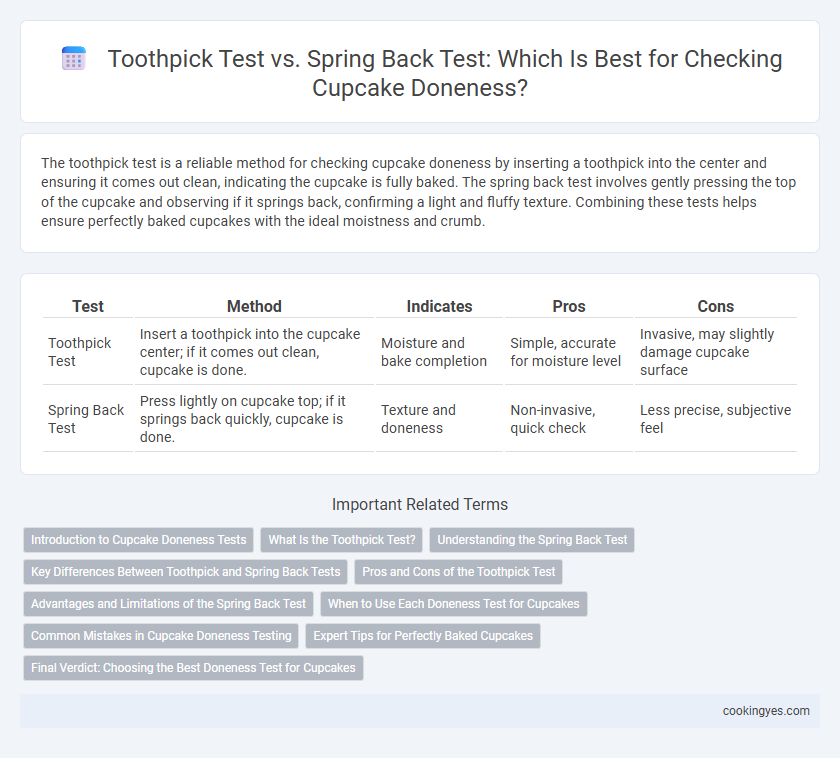The toothpick test is a reliable method for checking cupcake doneness by inserting a toothpick into the center and ensuring it comes out clean, indicating the cupcake is fully baked. The spring back test involves gently pressing the top of the cupcake and observing if it springs back, confirming a light and fluffy texture. Combining these tests helps ensure perfectly baked cupcakes with the ideal moistness and crumb.
Table of Comparison
| Test | Method | Indicates | Pros | Cons |
|---|---|---|---|---|
| Toothpick Test | Insert a toothpick into the cupcake center; if it comes out clean, cupcake is done. | Moisture and bake completion | Simple, accurate for moisture level | Invasive, may slightly damage cupcake surface |
| Spring Back Test | Press lightly on cupcake top; if it springs back quickly, cupcake is done. | Texture and doneness | Non-invasive, quick check | Less precise, subjective feel |
Introduction to Cupcake Doneness Tests
To determine cupcake doneness, the toothpick test involves inserting a toothpick into the center to check for moist batter or crumbs clinging to it, indicating whether the cupcake is fully baked. The spring back test assesses doneness by gently pressing the cupcake's surface; if it springs back quickly, the cupcake is likely baked through. Both tests provide reliable, simple methods to ensure perfectly baked cupcakes without over or undercooking.
What Is the Toothpick Test?
The toothpick test for cupcake doneness involves inserting a clean toothpick into the center of the cupcake and checking for moist crumbs or batter sticking to it. If the toothpick comes out clean or with only a few dry crumbs, the cupcake is fully baked and ready to be removed from the oven. This method is a reliable indicator of internal texture and ensures cupcakes are neither undercooked nor overbaked.
Understanding the Spring Back Test
The Spring Back Test evaluates cupcake doneness by gently pressing the top surface to see if it quickly returns to its original shape, indicating proper baking and moisture retention. Unlike the Toothpick Test, which checks for dry crumbs to confirm internal cooking, the Spring Back Test focuses on the cake's texture and firmness, providing a quicker, non-invasive assessment. This method helps bakers avoid overbaking, ensuring a soft, moist cupcake with optimal crumb structure.
Key Differences Between Toothpick and Spring Back Tests
The toothpick test determines cupcake doneness by inserting a toothpick into the center, revealing moist crumbs if undercooked or clean if fully baked, while the spring back test relies on gently pressing the cupcake's top to check for immediate bounce-back, indicating readiness. The toothpick test provides a direct internal check of baking progress, whereas the spring back test assesses surface texture and firmness. Both methods are effective but differ in technique: one requires physical insertion and inspection, the other tactile sensitivity and observation.
Pros and Cons of the Toothpick Test
The toothpick test effectively detects cupcake doneness by inserting a toothpick into the center to check for raw batter residues, offering a straightforward and widely accessible method. This test provides a clear indication of moisture content but may yield false negatives if crumbs cling to the toothpick, leading to potential under- or over-baking. Unlike the spring back test, the toothpick test doesn't assess texture or firmness, focusing solely on doneness through batter consistency.
Advantages and Limitations of the Spring Back Test
The spring back test offers a quick and non-invasive method to assess cupcake doneness by gently pressing the top and observing if it bounces back, indicating proper baking without needing to penetrate the cupcake like the toothpick test. This method preserves the cupcake's surface and prevents moisture loss, maintaining texture and presentation. However, its limitation lies in the subjectivity and variability of finger pressure, which can lead to inconsistent results compared to the more definitive toothpick test that detects internal moisture through a visual cue.
When to Use Each Doneness Test for Cupcakes
The toothpick test is ideal for checking cupcake doneness early in baking, as inserting it into the center reveals whether the batter is still wet or fully cooked. The spring back test is more effective toward the end of baking, where gently pressing the cupcake's surface shows if it has firmed up and bounced back, indicating doneness. Using the toothpick test first avoids underbaking, while the spring back test ensures cupcakes are not overbaked, preserving moistness and texture.
Common Mistakes in Cupcake Doneness Testing
Common mistakes in cupcake doneness testing include relying solely on the toothpick test, which can be misleading if crumbs stick to the toothpick, and ignoring the spring back test, where a gentle press on the cupcake top should cause it to rebound quickly. Overbaking often occurs when bakers misinterpret a dry toothpick result, while underbaking happens if the cupcake surface springs back too slowly or not at all. Combining both tests ensures accurate assessment of the cupcake's moist, fully baked interior without overcooking.
Expert Tips for Perfectly Baked Cupcakes
The toothpick test reveals cupcake doneness by inserting a clean toothpick into the center; if it comes out clean or with few crumbs, the cupcake is perfectly baked. The spring back test assesses doneness by gently pressing the cupcake's surface--if it springs back quickly, the cupcake is fully cooked without being overbaked. Expert bakers recommend combining both tests for reliable results, ensuring moist, tender cupcakes with ideal texture and crumb.
Final Verdict: Choosing the Best Doneness Test for Cupcakes
The toothpick test remains the most reliable method to check cupcake doneness, as it clearly indicates whether the center is fully baked by showing dry crumbs or batter residue. The spring back test, while useful for assessing texture, can be subjective and less precise in determining complete doneness. For consistently perfect cupcakes, combining the toothpick test with visual cues like golden edges ensures optimal baking results.
Toothpick test vs Spring back test for cupcake doneness Infographic

 cookingyes.com
cookingyes.com